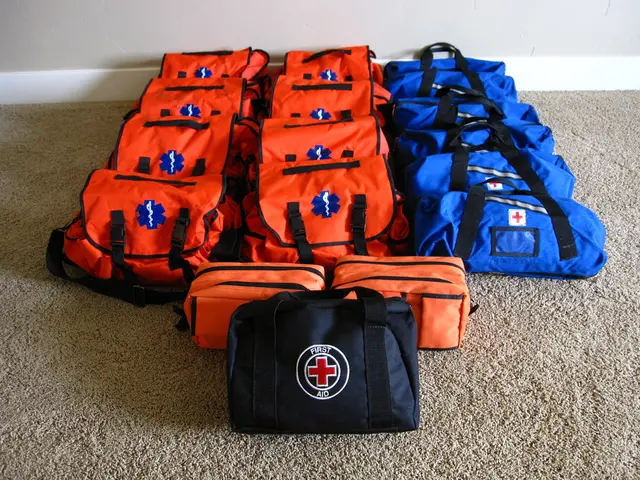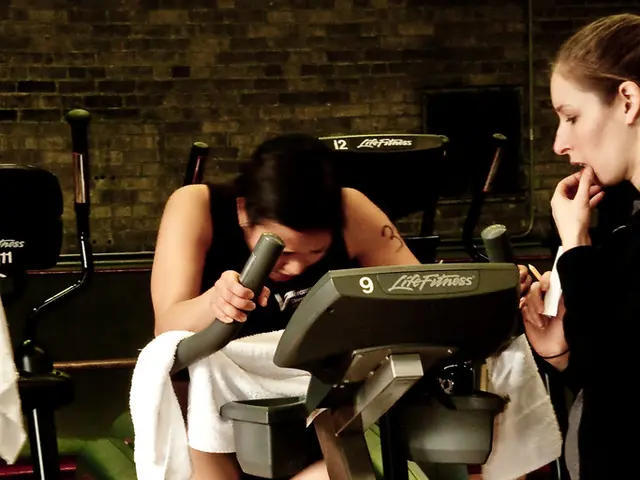If Knee Discomfort is Bothering You, Learn About Psoriatic Arthritis Affecting the Knee
Unfiltered Guide to Psoriatic Arthritis and Its Effects on Your Knees
Psoriatic arthritis (PsA), this swine of a condition feeds off both psoriasis and arthritis, leaving you with the delightful combination of itchy, flaky skin and sore, swollen joints, particularly your knees.
Here's the lowdown on this joint-wrecking condition and how to tackle it.
PsA Strikes Your Knees
PsA is an inflammatory condition that can make your joints ache, swell, and stiff. Along with the usual psoriasis symptoms like red, scaly patches of skin, you might experience:
- Knee Troubles: PsA can wreak havoc on your knees, causing pain, swelling, and stiffness.
- Skin Irritations: Classic psoriasis symptoms could pop up on your knees, elbows, feet, or hands.
PsA treatment is custom-tailored to your symptoms. Your doctor may suggest creams, pills, or physical therapy.
PsA: The Breakdown
PsA is a type of inflammatory arthritis that crops up in about one-third of people with psoriasis. Its shapeshifting nature can manifest in five distinct forms:
- Spondyloarthritis
- Arthritis Mutilans
- Polyarthritis
- Oligoarthritis
- Distal Interphalangeal Predominant
Symptoms of PsA in Your Knees
PsA symptoms can range from a niggling discomfort to an agonizing pain of 10 out of 10. If it sets up shop in your knees, you might encounter:
- knees crying out with pain
- limited mobility
- reduced flexibility
- swelling and stiffness
- tenderness, redness, and warmth
- pain while bending or extending your knee
- a grating sensation when you bend your knee
- cracking or popping noises when you bend or extend your knee
A Word about PsA
PsA doesn't just strike your joints—it can also trigger:
- fatigue
- eye inflammation
- muscle weakness
- ** engorged fingers and toes**
- back pain and inflammation
- crumbling, pitted, or ridged nails
- tummy troubles like diarrhea, bloating, or constipation
Visualizing PsA in Your Knees
Spotting PsA in your knees without an X-ray can be tough. You might notice some swelling or psoriasis-like patches on your skin. Some people may not have any visible symptoms.
The Root of PsA
The roots of PsA remain shrouded in mystery, with researchers still uncertain about how it develops. Genetics might play a role in increasing your risk. Other factors that could contribute include:

- drinking too much hooch
- obesity
- smoking
- nail disease
- severe psoriasis
- traumatic injuries
PsA can make its appearance at any age, but symptoms often start around 10 years after psoriasis skin issues show up. Its typical age range is between 30 and 50.
Can PsA Be Prevented?
There's no fool-proof way to dodge PsA, but you may be able to lower your likelihood of a flare-up by dodging triggers like skin infections, stress, skipped medication, skin injuries, and joint injuries.
An anti-inflammatory diet might also help fight off inflammation:
- nuts
- seeds
- onions
- berries
- olive oil
- fatty fish like tuna and salmon
PsA Treatments
While there's no cure for PsA, there are some stellar treatments that can ease symptoms and slow the disease's progression:
- Topical Treatments: Creams and gels can numb mild discomfort. Just remember to steer clear of products with alcohol, fragrances, or sulfates, as they can aggravate psoriasis.
- Physical Therapy: A physical therapy regimen can strengthen your knee, reducing pain and increasing mobility.
- Injections: Corticosteroids can reduce swelling and pain.
- Over-the-Counter Pills: Nonsteroidal anti-inflammatory drugs (NSAIDs) like ibuprofen and acetaminophen can help reduce pain and swelling.
- Prescription Medications: Disease-modifying antirheumatic drugs (DMARDs) can suppress your immune system to help control inflammation.
- Surgery: Joint replacement might become necessary if your knee joints are severely damaged.
Treating PsA in Your Knees at Home
You can try these tricks to manage your PsA symptoms at home:
- Sleep: Maintain a regular sleep routine.
- Baths and Heating Pads: Soothe pain with hot baths or heating pads.
- Ice: Use an ice pack to lower swelling.
- Knee Brace: Use a knee brace to hold your joint in place.
- Relaxation Techniques: Reduce stress with meditation or breathing exercises.
- Comfy Shoes: Wear shoes with shock absorption to reduce stress on your knees.
- Weight Management: Keep stress off your joints by maintaining a healthy weight.
- Exercise: Try low-impact activities like swimming, walking, or yoga to avoid putting too much pressure on your knees.
- Assistive Devices: Use a walker or cane to lighten the load on your knees.
- Steer Clear of High-Impact Activities: Avoid dancing, running, and jumping until your knee feels better.
Remember: Home remedies aren't meant to replace professional medical care. Use them only if your doctor gives the green light.
Seek Medical Attention
Catching PsA early gives you the best chance of slowing its progression. Consult a doctor if:
- your psoriasis flares
- your knee is warm, swollen, red, or painful
- you experience persistent morning stiffness
- you can't bend or extend your knee
- you have trouble bearing weight on your knee
The Big Picture
PsA is an inflammatory condition that affects about 30 percent of people with psoriasis. It can cause pain, swelling, and stiffness in your joints, especially in the knees. When it ravages your knees, PsA can limit your mobility and make everyday tasks challenging.
While there's no cure yet, there are ways to manage your symptoms and minimize the damage.
- PsA can cause pain, swelling, and stiffness in your knee joints, which are common symptoms of psoriatic arthritis (PsA).
- If PsA affects your knees, you may experience limited mobility and reduced flexibility, making everyday tasks challenging.
- The likelihood of developing PsA increases if you have a history of psoriasis, and it can manifest in five distinct forms — Spondyloarthritis, Arthritis Mutilans, Polyarthritis, Oligoarthritis, and Distal Interphalangeal Predominant.
- Managing symptoms at home can involve maintaining a regular sleep routine, using a knee brace, practicing relaxation techniques, wearing comfortable shoes, managing weight, and doing low-impact exercises like swimming, walking, or yoga. However, it's essential to consult a doctor if you notice any persistent knee trouble, warm, swollen, red, or painful knees, persistent morning stiffness, trouble bending or extending your knee, or difficulty bearing weight on your knee.





